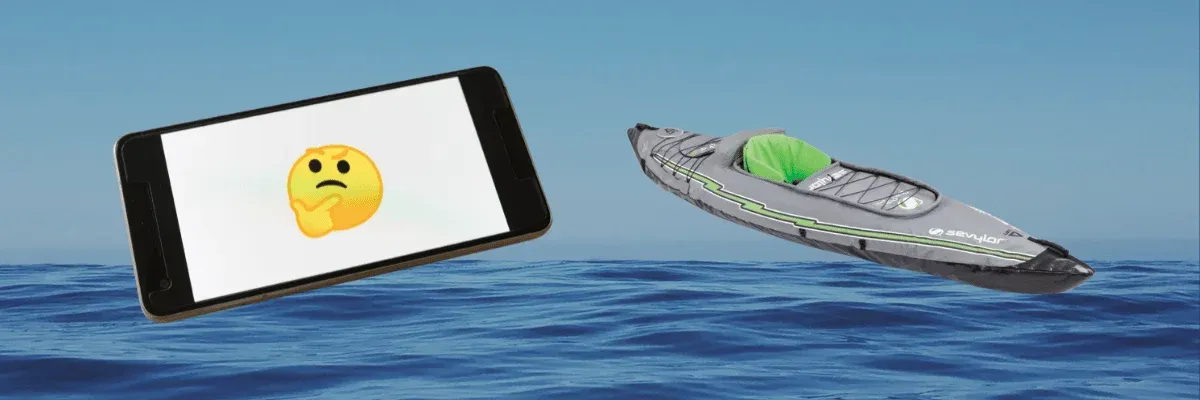Owning an inflatable kayak opens up a world of aquatic adventure without the storage and transport headaches of a traditional hardshell. But when it comes to taking care of your inflatable boat, there are some important considerations to keep in mind, especially regarding storage. Can you leave your inflatable kayak outside? Let's dive into the details.
Key Takeaways:
- Understand the risks of leaving your inflatable kayak exposed to the elements.
- Learn the best practices for storing your inflatable kayak to extend its lifespan.
- Discover tips for maintaining your kayak when outdoor storage is your only option.

The Risks of Outdoor Storage
Leaving your inflatable kayak outside might seem like a convenient option, but it's not without risks. Most inflatable kayaks are made from materials that can be sensitive to prolonged exposure to direct sunlight, extreme temperatures, and harsh weather conditions. UV rays can degrade the material, causing it to become brittle and more susceptible to punctures. Additionally, fluctuating temperatures can lead to the expansion and contraction of the air inside your kayak, potentially affecting its performance and longevity.

Protecting Your Kayak from the Elements
If you must store your inflatable kayak outside, it's crucial to protect it from the elements as much as possible. A well-ventilated, water-resistant cover can shield your kayak from direct sunlight and precipitation. Ensure the cover is not too tight to allow for air circulation, which helps prevent mold and mildew growth. Positioning your kayak in a shaded area, away from direct sunlight, can also minimize UV damage.
The Importance of Proper Inflation
When deciding whether to leave your kayak inflated or deflated, consider the balance between convenience and care. Keeping your kayak inflated can save time on setup, but it also leaves it vulnerable to temperature-related pressure changes. On the other hand, storing your inflatable boat deflated can reduce stress on the seams and material, but it requires more effort to inflate it each time you use it.
Best Practices for Inflation and Storage
To store your inflatable kayak properly, it's best to partially deflate it, reducing the pressure to avoid stress on the seams and material. This also allows for some flexibility with temperature changes. However, don't deflate it completely, as a bit of air can help maintain the shape and prevent creases or folds that could weaken the material over time.
The Impact of Weather Conditions
Weather conditions can significantly affect the condition of your inflatable kayak. Heavy rain can pool in the boat, causing water damage, and strong winds can blow debris against it, leading to scratches or punctures. It's essential to consider these factors and take preventative measures, such as securing your kayak to avoid it being tossed around or damaged by the weather.

Creating a Safe Outdoor Storage Space
If you have no choice but to store your inflatable kayak outside, try to create a safe storage space. This could involve constructing a simple shelter or using a kayak stand to keep it off the ground, reducing the risk of damage from moisture, insects, or rodents. Ensure the area is clear of sharp objects and provides some protection from wind and precipitation.
The Role of Cleanliness in Outdoor Storage
Before leaving your inflatable boat outside, it's important to clean it thoroughly. Saltwater, sand, and debris can degrade the material over time, so rinse your kayak with fresh water and let it dry completely. Regular cleaning not only maintains the kayak's condition but also helps you spot any damage or wear that may need attention.
Maintaining Your Kayak's Appearance and Functionality
Regular maintenance goes beyond cleanliness. Inspect your kayak for any signs of wear, such as loose fittings or abrasions. Addressing these issues promptly can prevent them from becoming more serious. Applying a UV protectant can also help maintain the color and integrity of the material, keeping your kayak looking new and functioning well.
The Consequences of Neglect
Neglecting proper storage and maintenance can lead to a shorter lifespan for your inflatable kayak. Exposure to the elements without proper care can result in leaks, discoloration, and a decrease in performance. It's important to weigh the convenience of outdoor storage against the potential costs of replacing your kayak sooner than necessary.
Investing in Long-Term Kayak Care
Ultimately, the best way to store your inflatable kayak is indoors, in a cool, dry place away from direct sunlight. If you invest in a quality storage solution, such as a dedicated kayak rack or storage bag, you'll likely enjoy many more years of reliable service from your inflatable boat. Consider the long-term benefits of proper storage and care when making decisions about where and how to keep your kayak.

Summary
Leaving your inflatable kayak outside is not recommended due to the risks posed by direct sunlight, weather conditions, and potential damage. If outdoor storage is your only option, take steps to protect your kayak properly, such as using a cover, storing it in a shaded area, and maintaining partial inflation. Regular cleaning and maintenance are essential to extend the life of your inflatable boat. Investing in proper storage and care will ensure that your kayak remains a trusty companion on your water adventures for years to come.

FAQs
Can I leave my inflatable kayak outside in the winter?
It's not advisable to leave your inflatable kayak outside during winter. Cold temperatures can cause the material to become brittle and more prone to damage. If you must store it outside, ensure it is well-protected with a cover and partially deflated to accommodate air contraction.
How often should I clean my inflatable kayak if it's stored outside?
Clean your inflatable kayak after every use, especially if it's stored outside. This will help remove any salt, dirt, or debris that could degrade the material over time. Additionally, perform a thorough inspection and cleaning at least once a month to maintain its condition
What's the best way to protect my inflatable kayak from UV damage?
The best way to protect your inflatable kayak from UV damage is to store it away from direct sunlight, ideally indoors. If that's not possible, use a UV-resistant cover and apply a UV protectant spray to the material to help reduce the effects of sun exposure.









